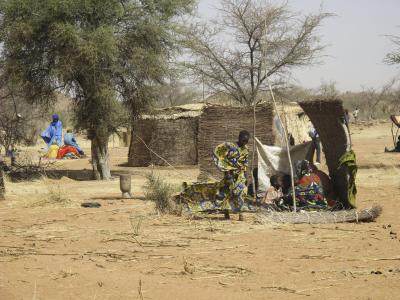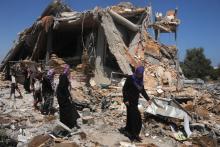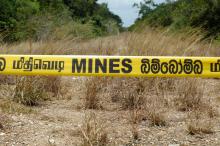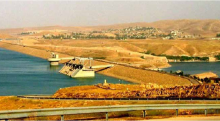Case prepared by Laura Di Gianfrancesco, Reine Pfister and Thilo Tesing, LL.M. students at Roma Tre University under the supervision of Giulio Bartolini (Professor) and Tommaso Natoli (Research assistant), Roma Tre University IHL Legal Clinic; with the contribution of Jemma Arman and Isabelle Gallino, LL.M. students at the Geneva Academy.
A. PRECAUTIONS IN ATTACKS DURING FRENCH OFFENSIVE
“[…] On 10 February [2013], 10-15 terrorists were barricaded in the Gao police station. The force commander (COMFOR) sent two armed columns, one to help the Malians destroy the resistance and protect journalists, the other to protect the hotel and evacuate those journalists who wanted to. A helicopter armed with HOT missiles was available to destroy the police station, but the force commander judged that using it in an urban area was too great a risk for civilians. Instead, he resorted to 30 mm shells.
[…]
Fighter-bombers were to avoid shooting where there was a risk of collateral damage. On January 11 in Konna, a Mirage used a delayed-fuse bomb to minimize collateral damage. On January 17 in Diabaly, a Mirage descended to shoot with its cannon - as opposed to dropping a bomb - to avoid collateral damage.
[…]
As a result, on several occasions, strikes were refused or aborted.
On January 16 in Konna, a Mirage aborted its bombing run due to the imbrications of French and jihadist forces.
On 26 January, a Mirage refused to drop its bombs in Gao, as a result of civilians being present.
On 9 February in Kaoussa, a Mirage declined to strike three suspect vehicles in an inhabited area because the pilot was not sure the individuals were aggressors as the presence of arms had not been confirmed. Instead, three helicopters flushed out the passengers and ascertained the presence of weapons. Once this was confirmed, the two vehicles which were armed were destroyed after the COMFOR’s authorization.
There were exceptions:
In non-urban areas (desert in the high North), ROE [Rules of Engagement] could be less strict. In the Adrar des Ifoghas, the whole brigade was, for a specific duration, given a blanket authorization to attack any element belonging to armed groups. On 25 February in the Ametettaï valley (high North), the commanders of the two GTIA [joint tactical groups (from the French “Groupements tactiques interarmes)] received an exceptional authorization: a complete delegation of authorization to fire by any means from the COMFOR. As the latter put it, “the absence of population and thus of risk of collateral damage, and the need to destroy a mobile enemy, led me to take this decision.” […]”
B. LEGAL CONSIDERATIONS SURROUNDING THE CONDUCT OF HOSTILITIES ON THE PART OF FRANCE
The strategists in the French army’s general staff drafted rules of engagement (ROE). With the help of their legal advisers, the general staff defined the conditions for planning and carrying out strikes against certain targets, such as command centres, munitions depots and the leaders of armed groups. In all of these operations, the legal objective was to make sure that every aspect of these operations complied with the principles of international humanitarian law (IHL), e.g. with regard to the distinction between military objectives and civilian objects and the principles of proportionality, military necessity and humanity.
[…]
In my view, operational personnel should not regard IHL as burdensome; on the contrary, they may well find it beneficial.
1.2. Complying with and relying on international humanitarian law: A constant requirement
Maintaining the legitimacy of our actions
The freedom that politicians and military staff have to act depends on their legitimacy. To ensure legitimacy, an operation must appear fair and be in line with our international obligations and universal ideals.
If that legitimacy exists, regardless of any moral or ethical questions that may arise, we can continue to enjoy the support of our fellow citizens and mobilize our allies.
We need to adopt an attitude whereby, to enjoy legitimacy, we must often restrict our actions more than official texts require us to, particularly in order to protect civilians and sensitive sites within our theatre of operations.
Any excessive or non-compliant use of force, whether by French troops or their allies, could undermine the legitimacy of an operation and limit the fruits of our successes in time and space. This means that all personnel, from the highest to the lowest, must have the right training so that they understand and follow the rules of engagement. Soldiers faced with a complex situation in a given theatre must know exactly what limits apply to their use of force. Naturally, these rules must apply to all aspects of operations, not just the use of lethal force.
The essential role played by legal advisers
Our legal advisers must ensure that personnel have a good understanding of the ROE and must provide basic or additional training to deployed troops. [...] Our military planners have clear rules governing the use of lethal force, only allowing its use against personnel taking a direct part in hostilities or belonging to organized armed groups, such as AQMI and MUJAO in Mali.
[…]
Personnel must be extremely careful, not only for obvious ethical reasons but also, and I must stress this again, to ensure legitimacy. That is why combat units must always use only the amount of force strictly necessary. That often means minimal force, although the use of lethal force is of course permitted.
[…]
With respect to what happened in Mali [...] we had to adapt our ROE three times to the situation in the field:
- The first set of rules, which corresponded to the high-intensity phase of the conflict, were extremely vigorous: we were faced with an enemy that was determined, well organized, well equipped and, most importantly, easily identifiable.
- After the battle in the Adrar des Ifoghas and the destruction of the armed groups’ last sanctuary, the ROE were changed so as to restrict air operations, notably to prevent collateral damage.
- A final set of ROE for the low-intensity phase of the conflict was put in place in late 2013 as things started to return to normal in northern Mali. This meant that the most coercive actions, particularly in targeting operations, required high-level approval.
Naturally, when the situation became more stable, there were fewer targeting operations that required lethal force: French personnel were asked to focus on taking prisoners, and only killing where capture was impossible.
In addition, a directive was issued stipulating zero tolerance for collateral damage. Our operation was carried out principally for the benefit of the people of Mali, so it was incompatible with civilian losses. I am happy to confirm that the French forces involved in Operation Serval did not cause a single civilian death. As I have already mentioned, it was vital that we preserved our legitimacy and avoided provoking hostility among the civilian population.
Discussion
I. Classification of the Situation and Applicable Law
1. How would you qualify the situation in Mali? What additional information would you require in order to make such a determination? Which rules of IHL apply? (
GC I-IV, Art. 3;
P II, Art. 1)
2. Does France’s involvement in Mali influence the classification of the situation? Which rules of IHL apply to France in Mali?
3. Does the classification of the situation matter for determining whether IHL was respected in this case?
II. Conduct of Hostilities and Precautions in Attack
4. Does a military objective become immune from attack if it is situated amongst the civilian population? (
CIHL, Rule 8)
5. Are airstrikes only lawful if there is a "zero expectation" of death and injury of civilians? Does the fact that civilian deaths and the destruction of civilian property are caused automatically mean that IHL is violated? Which fundamental principles applied to all airstrikes in this situation? Would the French Armed Forces have necessarily violated IHL if they had used HOT missiles in this situation? (
CIHL, Rules 1, 7, 14-21)
6. What precautionary measures did France take before launching attacks in “Operation Serval”? Did they go beyond what is required by IHL? Is it realistic to expect armed forces to have a “zero-tolerance” policy vis-à-vis collateral damage? Or to expect them, as Mrs Landais states, to impose upon themselves more constraints than those imposed by the law? (
CIHL, 15-21)
III. Elements Contributing to Respect for IHL
7. What are rules of engagement (ROEs)? How does the military develop and define them? Is there a legal obligation under IHL to have such rules? Why is the training of “all personnel, from the highest to the lowest,” important to ensure compliance with IHL?
8. In your opinion, what does Mrs Claire Landais mean when saying that the application of IHL should not be seen as a limitation to armed forces but, on the contrary, that it can be beneficial?
9. What are the advantages and the risks of involving lawyers in battlefield targeting decisions?
10. Why is the sympathy of international and national public opinion so important in armed conflicts? Why is the legitimacy argument such a decisive element in Mrs Landais’s statement?
11. Is all lawful conduct during armed conflict necessarily legimate too? What is the difference between legality (lawfulness) and legitimacy? Mrs Landais suggest that legitimacy may sometimes motivate belligerents to go beyond what the law requires; do you think that the reverse argument could also be correct: can legitimacy justify violations? Why?





